The Italian Coast Guard announced that the bodies of two elderly people were found in a flooded restaurant and the body of one passenger was located in a passageway on the Costa Concordia, raising the confirmed deaths from the grounding and sinking of the ship to six. There are still 15 passengers or crew missing following the casualty.
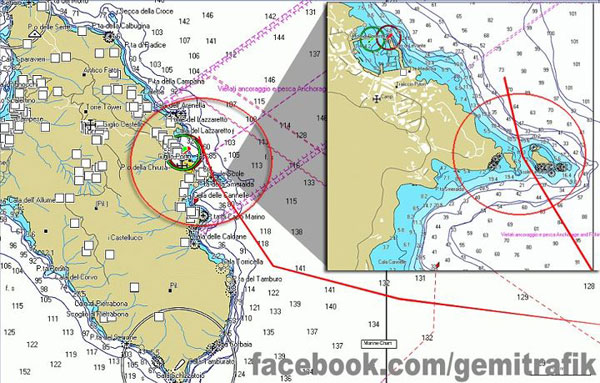
The question being asked by almost everyone is “how could this have happened to a modern cruise ship?” The Costa Concordia was a modern ship, operating in well charted waters, in good weather and calm seas. Obviously, despite a wide range of speculation, no one currently has the answer. What is known is often contradictory or simply mystifying. The captain maintains that the ship hit an uncharted rock and implies that there was nothing wrong with their course. If however AIS plots from various sources are accurate, the ship was steered very close to the island of Giglio and specifically cut through a passage near the popular dive spot, Le Scole, between two large rocks which was suitable only for vessels much smaller than the almost 1,000 foot long cruise ship. (Update: More recent AIS plots are showing a passage to the east of the islands, but still extremely close.)
Costa Concordia: A major navigational error, or what?
Continue reading
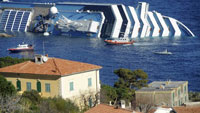 A Korean couple on their honeymoon, who had been trapped below decks on the cruise ship Costa Concordia for over 24 hours after the ship ran aground and sank in shallow water near the island of Giglio, off Italy’s Tuscan coast, were rescued yesterday. A third survivor; reportedly a member of the ship’s crew, suffering from a broken leg; was also found and taken by helicopter this morning to a hospital ashore. Italian officials now say that six crew members and 11 passengers are still missing out of the more than 4,200 people on board the cruise ship when she was evacuated. There are three confirmed dead among the passengers and crew.
A Korean couple on their honeymoon, who had been trapped below decks on the cruise ship Costa Concordia for over 24 hours after the ship ran aground and sank in shallow water near the island of Giglio, off Italy’s Tuscan coast, were rescued yesterday. A third survivor; reportedly a member of the ship’s crew, suffering from a broken leg; was also found and taken by helicopter this morning to a hospital ashore. Italian officials now say that six crew members and 11 passengers are still missing out of the more than 4,200 people on board the cruise ship when she was evacuated. There are three confirmed dead among the passengers and crew.
The ship’s captain, Francesco Schettino, 52, has been arrested, and is being detained in the nearby town of Grosseto on charges of multiple manslaughter, causing a shipwreck and abandoning ship. The captain claims that the ship was on course but had hit uncharted rocks, an assertion vigorously denied by local authorities.
 Just two hours after leaving port in Civitavecchia, the cruise ship Costa Concordia hit a reef near the island of Giglio, off Italy’s Tuscan coast, reportedly ripping a 165-foot gash in its hull. The ship began flooding and rolled on its side. 3,200 passengers and 1,000 crew were evacuated in a nightime rescue by lifeboats, local craft and helicopters. While there have been reports of six deaths, thus far only three bodies have been recovered. Divers have been brought in to search the flooded portions of the ship while the decks above water are being searched for missing passengers. Over 50 passengers are reported to be unaccounted for.
Just two hours after leaving port in Civitavecchia, the cruise ship Costa Concordia hit a reef near the island of Giglio, off Italy’s Tuscan coast, reportedly ripping a 165-foot gash in its hull. The ship began flooding and rolled on its side. 3,200 passengers and 1,000 crew were evacuated in a nightime rescue by lifeboats, local craft and helicopters. While there have been reports of six deaths, thus far only three bodies have been recovered. Divers have been brought in to search the flooded portions of the ship while the decks above water are being searched for missing passengers. Over 50 passengers are reported to be unaccounted for.
Italy cruise ship Costa Concordia aground near Giglio
Continue reading
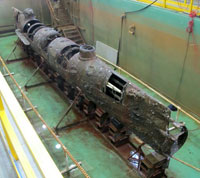 The Confederate Navy submarine H.L. Hunley was unveiled yesterday for the first time since it was recovered from the ocean floor near Charleston more than a decade ago. The vessel, a 42 feet long iron cylinder, is credited as the first “successful” submarine in that it sank the USS Housatonic on February 17, 1864 during the US Civil War. It was not a particular success in any other regard, as the Hunley sank before reaching port, killing her crew of eight. Prior to her first and only attack, the Hunley had sunk twice before, killing an additional 13 crew, including her inventor and namesake, Horace L. Hunley. The wreckage of the Hunley was discovered in 1970 by the archaeologist E. Lee Spence. The wreck was raised on August 8, 2000 and transported to the Charleston Navy Yard where it has undergone over a decade of research and restoration.
The Confederate Navy submarine H.L. Hunley was unveiled yesterday for the first time since it was recovered from the ocean floor near Charleston more than a decade ago. The vessel, a 42 feet long iron cylinder, is credited as the first “successful” submarine in that it sank the USS Housatonic on February 17, 1864 during the US Civil War. It was not a particular success in any other regard, as the Hunley sank before reaching port, killing her crew of eight. Prior to her first and only attack, the Hunley had sunk twice before, killing an additional 13 crew, including her inventor and namesake, Horace L. Hunley. The wreckage of the Hunley was discovered in 1970 by the archaeologist E. Lee Spence. The wreck was raised on August 8, 2000 and transported to the Charleston Navy Yard where it has undergone over a decade of research and restoration.
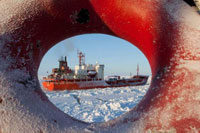 The Russian tanker Renda, carrying 1.3 million gallons of emergency fuel, escorted by the USCG icebreaker Healy are within 6 NM of Nome, Alaska on Friday morning. They are waiting for sunrise before advancing closer. Daylight will make moving though the ice safer and will help to pinpoint the staging area from whence they can start discharging the cargo of diesel oil and gasoline. Dawn in Nome today arrives at Nome at around 11:30 AM local time (9:30 PM GMT.)
The Russian tanker Renda, carrying 1.3 million gallons of emergency fuel, escorted by the USCG icebreaker Healy are within 6 NM of Nome, Alaska on Friday morning. They are waiting for sunrise before advancing closer. Daylight will make moving though the ice safer and will help to pinpoint the staging area from whence they can start discharging the cargo of diesel oil and gasoline. Dawn in Nome today arrives at Nome at around 11:30 AM local time (9:30 PM GMT.)
 We recently posted about a minor kerfuffle involving Dutch bureaucrats who were unhappy over 16 year old Laura Dekker not keeping up with her school work while sailing alone around the world. It brought to mind the old adage from Mark Twain, “Don’t let schooling interfere with your education.” Laura recently seemed to be making almost the same point, without directly addressing schooling:
We recently posted about a minor kerfuffle involving Dutch bureaucrats who were unhappy over 16 year old Laura Dekker not keeping up with her school work while sailing alone around the world. It brought to mind the old adage from Mark Twain, “Don’t let schooling interfere with your education.” Laura recently seemed to be making almost the same point, without directly addressing schooling:
“I am looking forward to my arrival and officially end my journey even though I feel like I already accomplished what I had set out to do a long time ago,” Dekker writes. “I have learned very much about myself along the way and I also have learned very much from all the different places and the many different people that I came in contact with in so many different countries.”
I wonder if the distraught bureaucrats can understand the scope of what Laura has learned as it compares to their incomplete lesson plans.
Continue reading
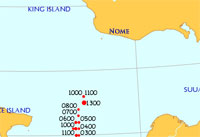 The internet is a wonderful thing. I am sitting in my office, which is around 70 degrees F (21 degrees C), drinking a hot cup of coffee, while tracking the painfully slow progress of the USCG Icebreaker Healy as it escorts the Russian tanker Renda through sea ice in the Bering Sea in an attempt to deliver emergency fuel supplies to the Alaskan town of Nome. On the decks of the Healy, the temperature is -11 degrees F (-24 degress C.) In the last 12 hours, the ships have averaged less than 3 knots. They are currently about 70 NM from Nome.
The internet is a wonderful thing. I am sitting in my office, which is around 70 degrees F (21 degrees C), drinking a hot cup of coffee, while tracking the painfully slow progress of the USCG Icebreaker Healy as it escorts the Russian tanker Renda through sea ice in the Bering Sea in an attempt to deliver emergency fuel supplies to the Alaskan town of Nome. On the decks of the Healy, the temperature is -11 degrees F (-24 degress C.) In the last 12 hours, the ships have averaged less than 3 knots. They are currently about 70 NM from Nome.
Thanks to Wendy for pointing out the Sailwx.org page – USCGC Healy — NEPP — position and weather.
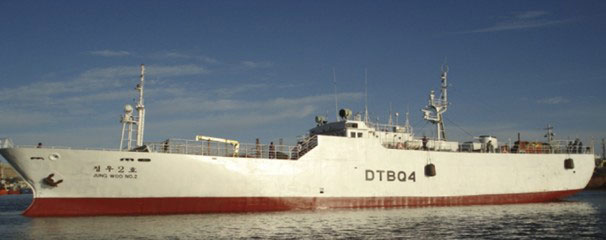
3 sailors died in fire on Jung Woo Photo: CCAMLR, Natasha/Associated Press
The Patagonian toothfish, better known on Western restaurant menus as Chilean sea bass, is in high demand. Living in the colder waters of the southern oceans, including Antarctica’s Ross Sea, fishing for the toothfish can be hazardous. Within the last 30 days, 25 sailors on fishing vessels in the Ross Sea have died. On December 13th, the Korean fishing boat, No.1 In Sung, sank in the Ross Sea with a loss of 22 dead or missing. 20 sailors survived and were picked up by other fishing vessels. The ship sank in light winds and a relatively mild 3-foot swell. The cause of the sinking has not been determined.
Three days later, the Russian fishing vessel Sparta was holed by sea ice and came perilously close to sinking off the Ross ice shelf. In addition to the damage to the ship, it became trapped in ice and was ultimately had to be rescued by the Korean icebreaker Araon. The Sparta was able to make temporary repairs and there was no loss of life.
At 3AM Wednesday, New Zealand time, a fire broke out on the Korean fishing vessel, Jung Woo 2, in the Ross Sea off Antarctica, killing three and seriously injuring two others. 37 sailors were rescued from the burning ship. which reportedly continues to burn and appears to be sinking.
Continue reading

Tanker Renda in the Ice
When the sled dog, Balto, arrived with emergency supplies for the icebound town of Nome in 1926, a statue was erected in his honor in New York City’s Central park. When the Russian ice strengthened tanker Renda, escorted by the USCG’s icebreaker Healy arrive in Nome with emergency fuel for the winter, they will most likely be greeted by lawsuits. That is, if, they finally arrive. Yesterday, there were reports that shifting ice had effectively stopped their progress. Today, however, conditions have improved and the ships are less than 100 NM from Nome, the Western Alaskan town which will run out of fuel before spring unless new supplies arrive. If the Healy and the Renda, with 1.3 million gallons of oil, makes it through the ice, they will be the first ships ever to resupply the icebound town in the winter. There are no through roads to Nome. If the Renda fails to reach the town, delivery of fuel by plane could cost two to three times more than by water. If all goes well the Renda and the Healy could arrive in Nome by Thursday.
Tanker carrying fuel less than 100 miles from Nome
Continue reading
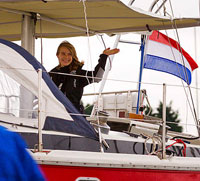
A Dutch flag no more, Laura now flies the flag of New Zealand
Laura Dekker’s sailboat, Guppy, now flies a New Zealand flag from her stern. Laura has struck the Dutch colors as the bureaucrats who tried and initially succeeded in stopping her solo voyage have returned to pester her and her family once more. They are now complaining that Laura has not kept up with her school work. In 2009, a Dutch court blocked Dekker’s planned voyage and put her under the custody of the Council for Child Protection, the Dutch government’s umbrella childcare agency. That order was reversed in July of 2010. One of the conditions of lifting the ban on her sailing was that she would continue her secondary-school education through an online teaching programme set up for Dutch-speaking children abroad. Now Dutch truant officers are upset that Laura has not been doing her homework.
Continue reading
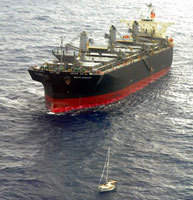
Bulk carrier White Kingdom approaching Corogin's damaged sailboat Photo:EPA
The good news is that the Chilean Navy, assisted by the Japanese merchant ship, White Kingdom, have rescued Thomas Louis Corogin, an 84-year-old American sailor, after his seventh failed attempt to round Cape Horn, single handed. Corogin is now safely ashore after the mast on his Westsail 32 sailboat cracked when the backstay failed. The bad news is that Mr. Corogin is not ruling out another try. He has been quoted as saying on his arrival onshore, “Age means nothing. What is important is that you are alive, so I don’t worry about numbers. I worry about life. That, I think, is more important.’’
After a search by the Chilean Navy, Corogin was ultimately picked up by the Japanese merchant vessel White Kingdom, a 53,400 DWT bulk carrier. A Chilean Navy frigate with a helicopter and medical team then picked him up for transport to shore. The Chilean government is paying for the entire cost of the rescue.
This may be an example of when persistence is not necessarily a virtue. Thanks to Phil Leon for passing the story along.
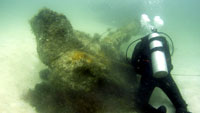
Wreckage of the USS Narcissus
When I was in high school in Flordia, before I learned the error of my ways and become a sailor, I ran all over Boca Ciega Bay and the around the mouth of Tampa Bay in an outboard motor powered skiff. One place I was particularly fond of was Egmont Key, just off the shipping channel into Tampa Bay. At one end of the island was the lighthouse and the pilot’s station where the harbor pilots waited for ships entering from the Gulf of Mexico. Along the Gulf-side beach were old gun emplacements from the Spanish-American war as well as lumbering gopher tortoises and waters full of pods of dolphins, black fin sharks and schools of rays.
Just off Egmont Key is also the wreck of the Civil War wooden steam tug, USS Narcissus, which has emerged from the Gulf sands that swallowed her after she sank in 1866. The wreck is about 2 miles off the northern end of the island in only 15 feet of water. State officials have proposed making the shipwreck site Florida’s 12th underwater archaeological preserve.
USS Narcissus, Civil War shipwreck off Egmont Key, could become Florida’s 12th underwater preserve
Continue reading
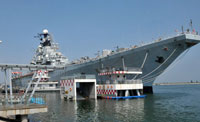
Hotel Kiev?
The Chinese are opening a 148 room luxury hotel in the refurbished Russian aircraft carrier Kiev. Since 2004, the aircraft carrier has been part of what is billed as “the world’s biggest military theme park” in Tianjin, a municipality close to Beijing. The Chinese also own the Russian aircraft carrier Minsk, a sister vessel to the Kiev, which is the centerpiece of Minsk World, a military theme park in Shenzhen, China. The Chinese military owns a third Russian carrier, the Varyag, whose keel was laid in 1985 but which was never finished. The Chinese have been working to finish the ship as an aircraft carrier for roughly the last decade. The ship returned from a second round of sea trials in mid-December and is said to be near completion but is not yet capable of landing planes on its deck.
Continue reading
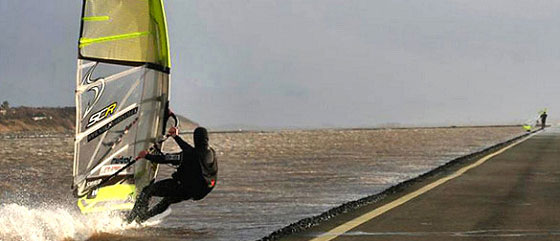
Photo: Sarah Jane Owen
British windsurfer, Steve Thorpe, was recently clocked at 50.48 knots, (58 mph or 93.3 km/hr,) sailing his windsurfer in 40 to 80 knots winds, in West Kirby, England. If the GPS readings are confirmed, he may hold the title of the world’s fastest windsurfer.
The Russian tanker Renda and the USCG icebreaking cutter Healy are on a rescue mission to the Alaskan city of Nome. After a major storm prevented a pre-winter fuel delivery by barge, the Russian tanker Renda was chartered to deliver 1.3 million gallons of diesel fuel and gasoline to the town of 3,600. Without the emergency resupply the residents would have run out of fuel before spring. The Renda is an ice strengthened tanker but found itself repeatedly stuck in sea ice last week. The Coast Guard icebreaking cutter Healy has had to cut paths for the tanker through ice that has ranged from 10 inches thick to several 5 foot thick pressure ridges. Both ships are now expected to arrive in Nome on Monday or Tuesday. When the ships arrive it will be the first time petroleum products have been delivered by sea to a Western Alaska community in winter.
Fuel tanker Renda escorted by Coast Guard ice breaker Arctic sea ice
[iframe: width=”560″ height=”315″ src=”http://www.youtube.com/embed/sP9Ioq0K9fk” frameborder=”0″ allowfullscreen]
Continue reading
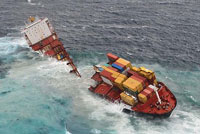 In early October, the MV Rena, a container ship owned by the Greek shipping company Costamare Inc, ran hard aground on the Astrolabe Reef in in the Bay of Plenty off New Zealand’s North Island. When she struck the reef, the Rena was loaded with approximately 2,100 containers and around 1,700 tonnes of heavy fuel. With the bow of the ship on the reef and the stern floating, structural cracking in the hull began to appear within two weeks of the grounding. The ship has now finally broken completely in half. There is now concern that the stern of the ship could sink, potentially causing a new oil spill. Also between 200 and 300 containers are believed to have fallen into the sea when the ship broke up, creating additional hazards to navigation. Thanks to Alaric Bond for passing the news along and the Phil Leon for pointing out the video.
In early October, the MV Rena, a container ship owned by the Greek shipping company Costamare Inc, ran hard aground on the Astrolabe Reef in in the Bay of Plenty off New Zealand’s North Island. When she struck the reef, the Rena was loaded with approximately 2,100 containers and around 1,700 tonnes of heavy fuel. With the bow of the ship on the reef and the stern floating, structural cracking in the hull began to appear within two weeks of the grounding. The ship has now finally broken completely in half. There is now concern that the stern of the ship could sink, potentially causing a new oil spill. Also between 200 and 300 containers are believed to have fallen into the sea when the ship broke up, creating additional hazards to navigation. Thanks to Alaric Bond for passing the news along and the Phil Leon for pointing out the video.
2012-01-08 – 3NEWS – RENA BREAKS IN HALF IN SEVERE STORMS
[iframe: src=’http://widget.newsinc.com/single.html?WID=2&VID=23560956&freewheel=69016&sitesection=toledoblade’ height=’320′ width=’425′ scrolling=’no’ frameborder=’0′ marginwidth=’0′ marginheight=’0′]
 In early December, on her maiden voyage, the VLOC (Very Large Ore Carrier) Vale Beijing suffered structural cracking while loading cargo in northeast Brasil. As reported by Maritime Propulsion , the extent of the damage was significant – the hull plating was found to have cracked in the vicinity of a water ballast tank, and from there water was making its way into a cargo hold. Vale Beijing is classed by DNV whose preliminary inspection reportedly described (in addition to the crack in outer hull plating) fairly substantial internal damage to web frames and longitudinals in the vicinity of the water ballast tank.
In early December, on her maiden voyage, the VLOC (Very Large Ore Carrier) Vale Beijing suffered structural cracking while loading cargo in northeast Brasil. As reported by Maritime Propulsion , the extent of the damage was significant – the hull plating was found to have cracked in the vicinity of a water ballast tank, and from there water was making its way into a cargo hold. Vale Beijing is classed by DNV whose preliminary inspection reportedly described (in addition to the crack in outer hull plating) fairly substantial internal damage to web frames and longitudinals in the vicinity of the water ballast tank.
Thanks to Dirk Bal for passing along a condition update and photos of the ship at anchor in the outer roads of Sao Luis, The Vale Beijing is one of 35 Valemax class ore carriers delivered or under construction and are the largest ore carriers ever built.
Continue reading
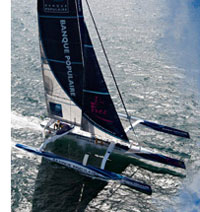 Update: Banque Populaire V crossed the line at 45 days, 13 hours, 42 minutes, 53 seconds, beating the previous record by 2 days and 18 hours. An amazing performance by Captain Loick Peyron and his crew. Our heartiest congratulations.
Update: Banque Populaire V crossed the line at 45 days, 13 hours, 42 minutes, 53 seconds, beating the previous record by 2 days and 18 hours. An amazing performance by Captain Loick Peyron and his crew. Our heartiest congratulations.
The live satellite map shows the maxi-trimaran Banque Populaire V within 40 nautical miles of the finish line sailing at roughly 30 knots. French skipper, Loick Peyron, and the crew of the maxi-tri are within hours of breaking the around the world speed record under sail and claiming the Jules Verne Trophy, smashing the previous record of 48 days 7 hrs and 45 min set by Frank Cammas’ Groupama 3 in 2010. Banque Populaire V should cross the finish line line after roughly 45 days, 14 hours.
Brian Thompson, the only Briton in the crew, reports, “Top speed I did on my last watch was 43.6 [knots]! That’s the fastest I will get to till the finish, as the wind will drop slowly. It might well have been my last full on blast on this mighty machine. We have been doing 800 miles a day, doing 35 knots, and you wonder if something will go wrong at those speeds.” Thompson will be the first Briton to circumnavigate the globe non-stop for a fourth time, beating existing records held by fellow sailors Dee Caffari MBE and Mike Golding OBE.
Brian Thompson thunders towards record books at 43 knots in Banque Populaire V
Continue reading

William Main Doerflinger Memorial Sea Shanty Sessions at the Noble Maritime Collection at Snug Harbor
This Saturday night, January7th, the Mystic Seaport will be hosting a “Chantey Blast and Pub Sing” from 1-5 PM in the Frohsinn Hall (aka the German Club), 54 Greenmanville Avenue, in Mystic CT as a fundraiser for the 33rd Annual Mystic Seaport Sea Music Festival coming up in June. The suggested donation is $15.
Around New York harbor, we have been fortunate to have had a monthly shanty (or chantey, if you prefer) sing for over a dozen years. In its current incarnation, it is called the William Main Doerflinger Memorial Sea Shanty Sessions at the Noble Maritime Collection at Snug Harbor. William Doeflinger, who died in 2000, “collected” many well known sea shanties at the Sailor’s Snug Harbor retirement home in Staten Island, NY. The shanty sing is held in one of the buildings where the old sailors sang their shanties for Doeflinger. The acoustics are great and there is a sense of magic as the old songs are sung again where sailors from the great age of sail lived out their final days. The shanty sessions are held on the third Sunday of every month. from 2 to 5 PM, at the Noble Maritime Collection at the Snug Harbor Cultural Center at 1000 Richmond Terrace, building D, in Staten Island New York. For a short video see our post: The William Main Doerflinger Memorial Shanty Session, 5/15/11
Continue reading
